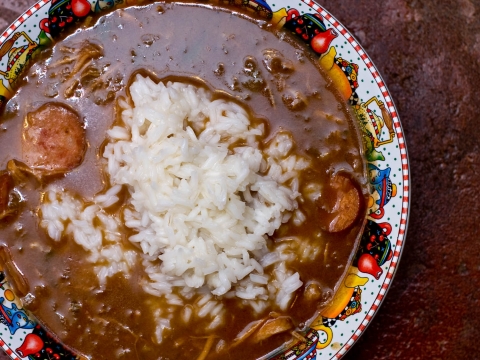
You can learn a lot about the history of Southern food by studying a bowl of gumbo. The very name conjures up a rich array of ingredients coming together in a single pot and melding into something rich and delicious. It represents the intersection of three cultures—European, Native American, and West African—that created what we know today as Southern cuisine.
In the case of gumbo, though, we really need to phrase it as the intersection of African, Native American, and European cultures, for that ordering more accurately captures the sequence in which the dish unfolded. These days, gumbo is closely associated with Louisiana and, more specifically, with Cajun cuisine, and for good reason. But it's actually far older than the Cajun presence in Louisiana, and historically, it has a much broader regional footprint. It's a prime example of how West African foodways took root in the Southern colonies and, over time, gave birth to some of the region's most iconic dishes.
At its most basic, what we call gumbo today is a savory stew made with a variety of meats or shellfish combined with an array of vegetables and herbs. From there, all bets are off. Gumbo can be as thin as soup or as thick as gravy. The proteins might be chicken and crab or sausage and shrimp. The stew might be thickened with okra, with filé (powdered sassafras leaves), with a dark roux (a blend of oil and flour cooked slowly until well browned), or any combination of the three.
Despite all this diversity, gumbo's development follows a logical progression, provided you can cut through a lot of bad assumptions and outright nonsense to get to it.
Let's start with the biggest red herring of all, the oft-repeated idea that gumbo is a variation of bouillabaisse, the classic fish stew from Provence. This notion is repeated everywhere from slapdash food blogs to peer-reviewed academic books. It's also completely wrong.
Yes, bouillabaisse is French, and a lot of French people migrated to Louisiana, where they ended up eating gumbo. But the two dishes are made in wholly different ways. Bouillabaisse begins with a rich broth to which an array of bone-on fish and shellfish are gradually added. The finished stew is served over or under slices of bread topped with rouille, a sort of saffron-laced mayonnaise. Even back in the 19th century, almost every commentary on bouillabaisse notes that the key to the dish is the variety of fin-fish used to make it, and that simmering that fish is vital to add complexity to the broth.
Of all the variations on gumbo out there, none of them start with broth in a pot, and even today fin-fish are almost never part of the dish. 19th century recipes make clear that okra and tomatoes were the original base ingredients, and the first protein that consistently found its way into the pot was chicken. Only later were shellfish like oysters and shrimp incorporated. It takes a remarkable leap of imagination—or, perhaps, a dull lack of it—to think that gumbo evolved from bouillabaisse.
So how did that connection come to be made in the first place? Lolis Eric Elie has a few ideas. A New Orleans native, Elie was a columnist for the Times-Picayune for 14 years, then became a script editor for the acclaimed HBO series Treme and now for AMC's Hell on Wheels. He has also been one of the strongest voices decrying the whitewashing of gumbo.
In a 2010 article for Oxford American, he methodically blasted food writers' long-standing habit of ignoring the contributions of black cooks to Louisiana's cuisine. Instead, he argued, those writers twist and bend to invent tenuous connections to every European food culture from Spain to New England—including crediting French elites with the first gumbo.
I asked Elie why he thought the bouillabaisse explanation has had such staying power. "The assumption has been," he says, "that anything you don't understand about New Orleans culture when you are an American, you assume that it's French."
But the French mystique can lead us astray. "Until relatively recently, we never studied the African influence on American culture," Elie says. "The assumption really was that the Europeans went and got these people who were capable of being taught things, but the people had nothing to contribute, so the assumption was the only contribution was labor."
In reality, no one needed to teach Africans how to cook gumbo. They brought its base ingredient with them to the New World and they cooked it using techniques that had been handed down from one generation to the next. Far from being a food tradition unique to Louisiana, gumbo is instead an important part of the larger fabric of African-based foodways in the South as a whole.

